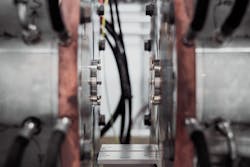Internal vs. Outsourced Fab: 7 Critical Project Planning Tricks
Deciding to run an in-house fabrication project instead of outsourcing, or vice versa, requires thinking far beyond dollar cost. Use these seven tricks to determine the actual cost of each option and how to make the best decision for your company.
The old adage holds true: The most valuable resource of all is time. When making critical decisions about your company, few considerations hold more weight than time and its Western grandchild: money. When contemplating whether to internally fab a product or hire third-party, there are seven critical steps you can take to make the right decision for your organization.
Use these tricks to ensure you make the right long-term decision that will keep your team running smoothly, keep you on budget, and even impress the board.
1. Accurately Scope Your Project
Whatever you already started doing, stop. No, seriously. Because if you haven’t prepared an accurate assessment of your project, you’re starting this race with your shoes tied. Before you can even pretend to know which type of fabrication is right for you, you must get a full-blown, 3D, 4K look at what will consume your organization for the next year(s).
In short, you must know what you’re fabbing. Duh. I know. But hear me out: Before you begin pricing or even draft your scope of work, you must know the intricate details of this project so that you can accurately determine the amount of time and money resources it will take to bring it to fruition.
Are you prototyping next-gen technologies that are completely independent of your stock value? Are you leading a full sprint to get a final product to market and you’re already behind? Are you just prototyping non-critical design spins?
With this, how much product do you need to make? Do you have the equipment, or will it be purchased specifically for this project? Could this new equipment also be used for another company product line?
Gather as much information as you can about this project. It will be the foundation for your assessment.
2. Deadline/Time
The next item to track is the deadline. When do you need to have results? Projects always take longer than expected (some say 1.5 times longer; and for me, well, perhaps I’m a slow learner). Regardless, know your deadline and the deliverables you need to have ready by that date. Map out your risks (you can even make an FMEA if you really feel really inspired), and start to piece together how much work your team will need to do to hit the soft deadline, so you can miss it and hit the hard deadline.
3. Manpower
Back to my time analogy: In business, the amount of time you have really comes down to manpower. How tapped out is your current team? Can you hit the deadline you put together in step 2 with your current team, or will you need to hire more manpower? Be realistic about time to recruit, time to onboard, and cost.
Fab projects take a lot of work. They require long hours and demand people go the extra mile because discoveries and breakthroughs generally happen during the eleventh hour. So be realistic with your manpower assessment.
A useful resource I’ve used is resource loading. The Project Management Institute offers free resources on the methodology if you need it. Essentially, resource loading takes an honest look at how thinly spread your team is week-to-week. It lets you know how much you can “load” your resources before the camel’s back breaks. It’s certainly not the only model and it isn’t without its blind sides, but it’s a good place to start.
4. Cost
The bottom line is, of course, an important factor. Consider, however, that the monetary cost and total cost of your project are not the same things.
When looking at monetary cost, you will certainly want to consider:
- Cost of machinery
- Cost of build materials
- Team labor cost per hour/day
- Volume price breaks (if outsourcing)
- Any fees/added costs (if outsourcing).
Still, even if internal fab is cheaper dollar-to-dollar, it might cost you more in other ways. That’s why it’s important to look at the total cost of the project.
For example, if you are making a niche product, finding a vendor skilled in that area may prove difficult or impossible. That’s a non-monetary cost that should be added to your evaluation. If you decide to outsource, add additional time to your project plan to account for the learning curve.
If you decide to fab in-house, be realistic about how much your team can focus on this “new fab” given responsibilities to other projects. Additionally, could you hire someone dedicated to the new fab project? Would that be more cost-effective—not just per hour, but also in that the person would be invested in your company?
There is no right or wrong answer. The idea is to really compare the true cost of both options, and the right answer for your company should reveal itself.
5. Account for Risk
We touched on this a little already, but be sure to account for risk. A different variety of hurdles arises with internal and external fab. Let’s say you do hire a dedicated employee to run the new fab project who subsequently falls ill. Worse yet, he spins your idea and launches his own startup. Is that a little farfetched? Sure, but it’s still a risk you could face.
Similarly, if you outsource your project, you could find material contaminants to be a real bottleneck for getting to market on time. What might be “clean” for CMOS fabrication could be filthy for your product, and disastrous for your needs.
With development, things go wrong all the time. Even with a trusted FMEA, new risks will blindside you. So, do your best to assess the critical risks of both, then roll with the punches. Because inflexibility never served anyone well.
6. Technology
Technology very well could be the deciding factor for your project. Sure, you could run the fab in house using 3D printers, milling machines, and whatever grade of equipment and materials your company could afford…or, you could outsource to a fab house that uses the newest, super-fast, automated risk-finding technologies.
Depending on your needs, having a super-duper supercomputer fab your products might greatly minimize your risk of error and get you to market faster. If that’s your goal, the choice is obvious. If you don’t need the bells and only sometimes need a whistle, then in-house fab could be for you.
7. Liability
The last consideration is liability. If you’re just doing a couple of design spins, this factor might not apply to you. If, however, you are preparing to release a product to market, liability is important. This is because if you are going to fab in-house, then you become responsible for securing all accreditations and certifications from the regulatory bodies that govern your industry.
If you don’t want to have to go through CE, FCC, ISO, and TCB certification processes (and that’s not even the half of it), then outsource. You can simply write in your requirements documentation that your products need to meet these standards, and the manufacturer will take care of the rest. Sometimes, peace of mind is worth the money.
Final Thought
There’s no real right or wrong way to do fab. It just depends on what your team can handle and the kind of experience you want. There are creative ways to fab on a shoestring budget, like getting a freelance engineer to prototype things for you through 3D Hubs. If you have a big budget, maybe you don’t want the headache of in-house fab and outsourcing is the obvious choice.
If you lead a smaller team, however, sometimes it’s just plain fun to take on the challenges of product development together. I promise the memories you’ll create will be worth it.
About the Author
Cabe Atwell
Engineer, Machinist, Maker, Writer. A graduate Electrical Engineer actively plying his expertise in the industry and at his company, Gunhead. When not designing/building, he creates a steady torrent of projects and content in the media world. Many of his projects and articles are online at element14 & SolidSmack, industry-focused work at EETimes & EDN, and offbeat articles at Make Magazine. Currently, you can find him hosting webinars and contributing to Penton’s Electronic Design and Machine Design.


